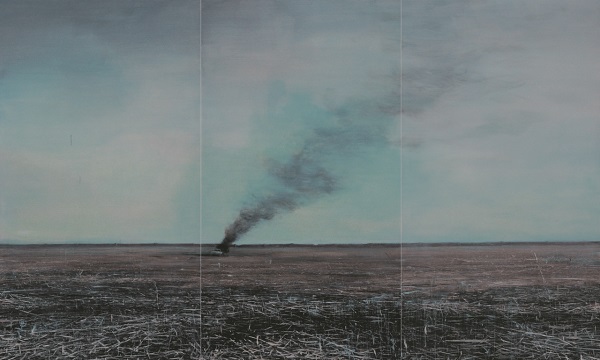
Illustrating Existence in The New Generation
platformchina
2013.05
“I do not want to stand apart from this reality. Rather, I want to go into this chaotic reality and be like it, be with it.” 1 This is how JiaAili, a young generation artist in China, describes his work. Having graduated from LuXun Academy of Fine Arts in 2004, Jia exhibited superb realist and stylistic techniques. In spite of this, he would forge his own distinct path, apart from the creative inclinations of the Academy.
In the 1990s the Chinese society has moved away from the collectivism-socialism of the 70s. The radically different upbringing has inspired this new generation of Chinese artists to possess a different mentality, away from the symbols of political and social reality. Instead, they would turn their attention towards the inner emotional world. Jia is a representative of this new generation, molding themselves into the rapidly changing environment. His focus on the personal psychological landscape unfolds itself in his canvases of vast alienation and nothingness. With his energetic and explosive brushstrokes,
amidst scenes of fantasy and apocalyptic ruins, Jia tells the psychological scape of the young generation. He seizes the cusp of the times and becomes the leader of the new wave, distinguishing himself as one of the high-profile young artists in recent years.
Born in 1979, Jia grew up in Dandong in the northeastern Liaoning Province, just a river away from North Korea. After graduating in 2004, Jia stayed at the Academy to teach, until he moved from Shenyang to a studio in Beijing. February Talk-Past (Bed) (Lot 855) was painted before the artist moved to Beijing in 2006. It is one of the largest-scale works from his earlier oeuvre, exerting grand magnificence in its own right. Consisting of three canvas-panels that measure approximately five meters long in total and three meters high, the piece exhibits the young artist's extraordinary control over such large pieces.
February Talk-Past (Bed) is part of the Wasteland series which includes works that expressed the artist's own emotional state in between 2005 to 2007. Empty scape, ocean, and the beach are backgrounds that are frequently seen in the series. In comparison with the grandiose setting, the scale of the human figure is almost always diminished into a petty position. At the same time, the colour palette is mainly focused on gray and blue, signifying the artist's strongest repression on his own emotion. "The scenes I like are of the ennui of a big group of people after reckless revelries, which seem to linger vaguely amidst the loneliness and melancholy."2 Indeed, the Wasteland series is a reflection on existence for the artist.
February Talk-Past (Bed) depicts a scene of boundless ruin. The horizon, which stretches from left to right, splits the indigo sky and cluttered ground, and at the end of the latter, closest to the sky, there is a bed. The circling smoke dyes the sky a dark gray. The expressive strokes sculpt the chaotic ground, while the sky is relatively smoother, creating contrasts and contradictions in this scene of desolation. Human existence is rendered insignificant in this world framed by an infinite sky, for we are accompanied only by loneliness and hopelessness; alienation exists-as the only state of being. Jia has mentioned that, "Human thinking is all insignificant. Everything done on earth and under the heavens is quite insignificant too."3 The chaotic wasteland becomes the site^of desperation, and upon this is a burning white bed, a symbol of complete disillusionment. “It is a kind of desperation: on the whole the world looks beautiful, but when you study its flaws up-close, it pains you to the core.”4 Filled with prophetic icons, these scenes would become riddles and parables. In this chaotic, fragmented world, everything is on the brink of collapse. For the artist, it seems that painting is the only manner to seize existence. “When I am alone in the studio putting this depression as paint on the canvas, I feel quite happy after all.”5
At the LuXun Academy of Fine Arts, Jia Aili was rigorously trained in the figure painting in the Soviet Socialist Realist tradition. However, he never shows off his amazing virtuosity, and instead strives for the effect of an epic tragedy. This sense of tragedy comes form Jia’s melancholia but also indirectly reflects the new generation's resistance towards and escapism from social transformations. “A young person like me is mentally repressed and melancholy, and I am depressed... I see no concrete contradictions in front of me, but only inchoate things. ”6 Even more serious is uncertainty about the future, “ I believe that Those adults once instilled in us hope will no longer give us tomorrow's answers... In the new century, we will still live ordinary lives.”7
In comparison to Jia Aili's works in recent years, the artist's earlier pieces are more emotional, which reflect the. artist's unique sensitivity. He grew up in a world with developed networks, in an age of interpersonal alienation, in a time of weak political and social consciousness. The mental outlook of the piece is comparatively personal and private, as the paintbrush outpours both restraint and calmness, it certainly represents a most grim mood not unlike that of the present age.
